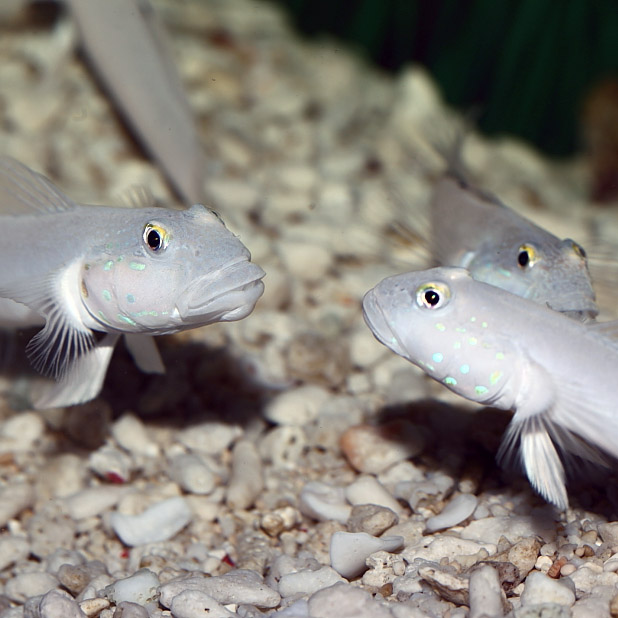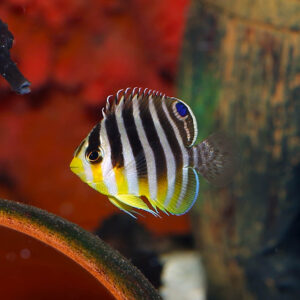The Chalk Goby, scientifically known as Valenciennea sexguttata, is a small and captivating fish with a maximum size of approximately 3 inches (7.6 cm). This species features a slender body with a pale whitish colouration, which gives it a chalk-like appearance.
Natural Habitat
Chalk Gobies are primarily found in the tropical waters of the Indo-Pacific region. They inhabit sandy and silty substrates near coral reefs, lagoons, and seagrass beds. These areas provide them with the perfect environment for burrowing and searching for food.
Keeping Chalk Gobies Healthy, Care Level, and Difficulty
Keeping Chalk Gobies healthy requires moderate care, making them suitable for both beginner and intermediate aquarists. They have a moderate difficulty level, as they can be sensitive to poor water conditions. Maintaining proper water quality and stability is essential for their well-being.
Special Requirements and Feeding
Chalk Gobies have specific requirements to thrive in an aquarium. They need a sand substrate that allows them to burrow, mimicking their natural behaviour. Additionally, providing plenty of hiding places, such as rocks or caves, helps create a secure environment for them.
In terms of feeding, Chalk Gobies are predominantly carnivorous. They primarily feed on small crustaceans, such as copepods and amphipods, found in the sand or gravel substrate. Supplementing their diet with: large pellets, high-quality frozen or live foods, like brine shrimp or mysis shrimp, is recommended to ensure proper nutrition.
How Many Should I Keep?
Chalk Gobies are relatively peaceful and can be kept singly or in small groups. If keeping multiple individuals, it is crucial to provide sufficient space to prevent territorial disputes. A general guideline is to allocate at least 10 gallons (38 litters) of water per Chalk Goby in the aquarium.
Lighting Preference
Chalk Gobies do not have specific lighting requirements. They will adapt well to a variety of lighting conditions, ranging from low to moderate intensity. Providing a natural day-night cycle with a suitable lighting duration is beneficial for their overall well-being.
Suitable Tank Mates
Chalk Gobies are generally compatible with a wide range of peaceful tank mates. Some suitable companions include small reef-safe fish, such as gobies, blennies, and small wrasses. It is advisable to avoid aggressive or large species that may intimidate or harm the Chalk Goby.
Sand Sifting Goby: Feeding Behaviour and Usefulness
The Chalk Goby plays a crucial role in aquariums by sifting through the sand bed in search of food. Using its specialized mouth and gill structures, it takes in mouthfuls of sand and expels it, while simultaneously filtering out tiny organisms and organic matter. This feeding behaviour not only helps to clean and aerate the substrate but also promotes nutrient cycling within the aquarium. By consuming detritus and algae, the Chalk Goby contributes to maintaining a healthier and more balanced aquatic environment.
Reproduction in the Wild
During courtship, the male chalk goby performs an elaborate display to attract a female mate. This display includes darting movements, fin flaring, and colouration changes. Once the female is ready to spawn, she releases eggs that the male fertilizes externally by releasing sperm over them. The fertilized eggs are then carried away by the ocean currents, where they hatch into larvae.
Breeding Valenciennea sexguttata
Breeding the Chalk Goby in captivity is a challenging yet rewarding endeavour. Here is a detailed breakdown of the breeding process:
- Set up:
Create a separate breeding tank with appropriate water parameters, including a temperature around 78-82°F (25-28°C) and salinity between 1.022 and 1.026 specific gravity. Provide suitable hiding places, such as PVC pipes or small tubes, for the gobies to construct their burrows.
- Courtship/Spawning:
The male initiates courtship by displaying vibrant colours, flaring fins, and performing zigzag movements to attract the female. Once the female is receptive, she will release a cloud of eggs, and the male will immediately fertilize them with his sperm. It is crucial to monitor the spawning closely and remove the eggs promptly to prevent predation.
- Rearing:
The fertilized eggs will hatch into larvae within 24-48 hours. Transfer the larvae to a specialized rearing tank with appropriate water conditions, including temperature, salinity, and lighting. Provide suitable live food, such as rotifers and copepods, to feed the larvae during their early stages. As they grow, gradually introduce newly hatched brine shrimp to their diet.
Sexual Dimorphism
Chalk Gobies do not exhibit significant sexual dimorphism, making it challenging to distinguish between males and females based on physical appearance alone. However, males may display more vibrant colours and exhibit more pronounced courtship behaviours compared to females.
Distribution
Chalk Gobies, including Valenciennea sexguttata, are native to the tropical waters of the Indo-Pacific region. While there are captive-bred and line-bred strains of Chalk Gobies available in the aquarium trade, the original fish originate from the wild populations found in the Indo-Pacific.
Summary
The Chalk Goby Valenciennea sexguttata is a small and visually striking fish with a chalk-like appearance. With its sand-sifting feeding behaviour, it contributes to substrate maintenance and overall water quality in aquariums. In the wild, Chalk Gobies engage in intricate courtship and external fertilization for reproduction. Breeding Chalk Gobies in captivity requires specific setup conditions and attentive care during courtship, spawning, and rearing stages. While they do not exhibit significant sexual dimorphism, males may display more vibrant colours and perform elaborate courtship displays.





Reviews
There are no reviews yet.